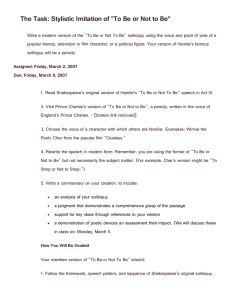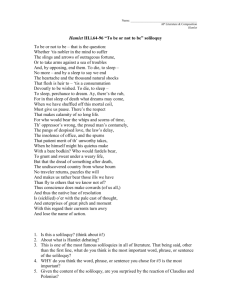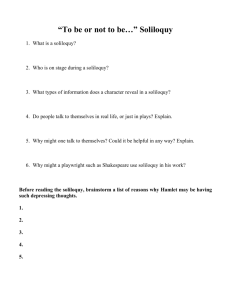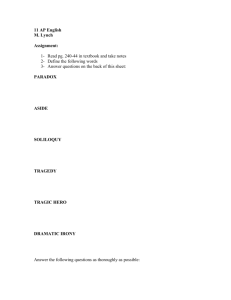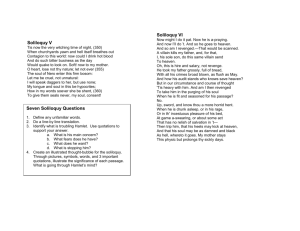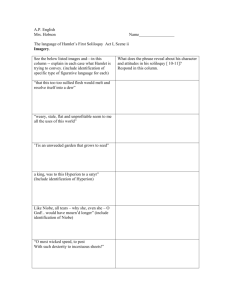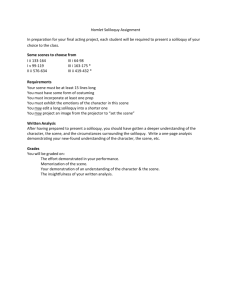Who's the Addressee? Four Types of Shakespearean Soliloquy
advertisement
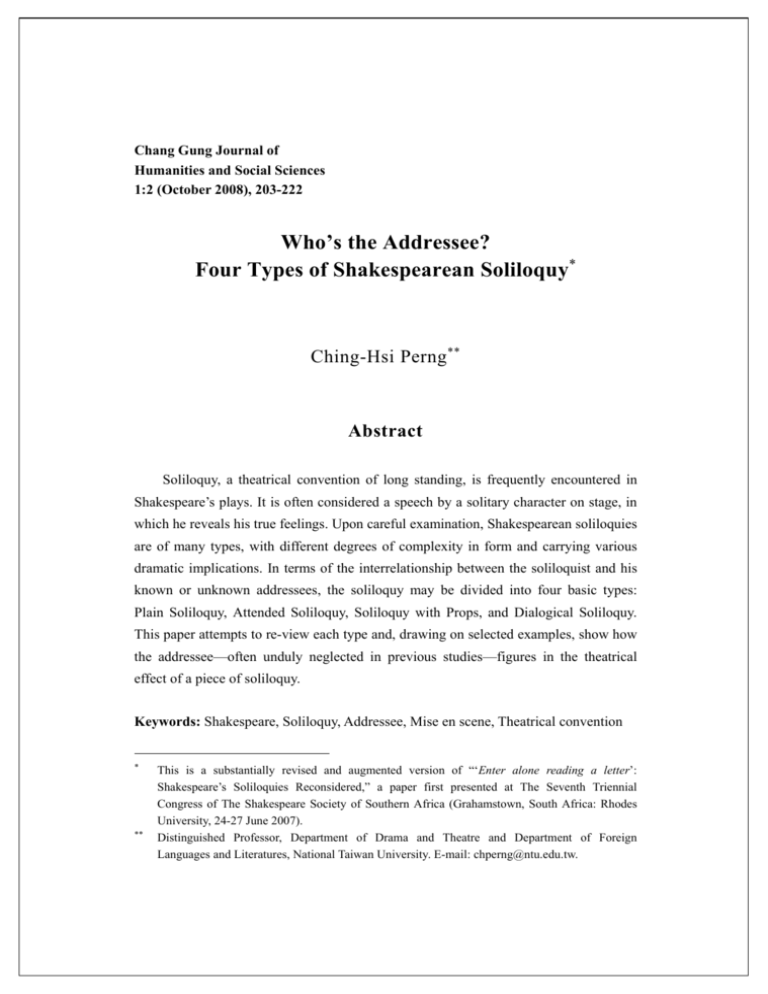
Chang Gung Journal of Humanities and Social Sciences 1:2 (October 2008), 203-222 Who’s the Addressee? Four Types of Shakespearean Soliloquy∗ Ching-Hsi Perng ∗∗ Abstract Soliloquy, a theatrical convention of long standing, is frequently encountered in Shakespeare’s plays. It is often considered a speech by a solitary character on stage, in which he reveals his true feelings. Upon careful examination, Shakespearean soliloquies are of many types, with different degrees of complexity in form and carrying various dramatic implications. In terms of the interrelationship between the soliloquist and his known or unknown addressees, the soliloquy may be divided into four basic types: Plain Soliloquy, Attended Soliloquy, Soliloquy with Props, and Dialogical Soliloquy. This paper attempts to re-view each type and, drawing on selected examples, show how the addressee—often unduly neglected in previous studies—figures in the theatrical effect of a piece of soliloquy. Keywords: Shakespeare, Soliloquy, Addressee, Mise en scene, Theatrical convention ∗ ∗∗ This is a substantially revised and augmented version of “‘Enter alone reading a letter’: Shakespeare’s Soliloquies Reconsidered,” a paper first presented at The Seventh Triennial Congress of The Shakespeare Society of Southern Africa (Grahamstown, South Africa: Rhodes University, 24-27 June 2007). Distinguished Professor, Department of Drama and Theatre and Department of Foreign Languages and Literatures, National Taiwan University. E-mail: chperng@ntu.edu.tw. Chang Gung Journal of Humanities and Social Sciences 1:2 (2008) Shakespearean soliloquies are of many types, with different degrees of complexity in form and carrying various dramatic implications. In terms of the interrelationship between the soliloquist and his known or unknown addressees, the soliloquy may be divided into four basic types: Plain Soliloquy, Attended Soliloquy, Soliloquy with Props, and Dialogical Soliloquy. In what follows each type will be re-viewed in an attempt to show how the addressee figures in the theatrical effect of a piece of soliloquy. 1. Defining Soliloquy Defining dramatic soliloquy seems easy. Its etymology tells us clearly that it consists of solus (“alone”) and loqui (“to speak”). This “aloneness” of the speaker has given rise to the term’s popular definition: “A speech given by a character who is alone on stage; generally represents a character’s inner thought through this convention” (Brockett and Ball 436, emphasis added). Lloyd A. Skiffington also sees it as “. . . a locution dominating the stage and the attention of the theatre audience, delivered by a speaker who is alone on the stage,” but he hastens to add that Prince Hamlet’s “Now might I do it pat” speech, spoken while King Claudius is seen on stage, praying, is an obvious exception (ix, emphasis added). These definitions make no mention of the addressee of the soliloquy. Patrick Tucker, a veteran actor, does not buy the theory that Shakespeare’s soliloquist talks to himself or to the invisible man. “In Shakespeare’s day-lit theatre,” he asserts, “this concept was beyond them [Shakespeare’s contemporaries], and a Soliloquy was when the character talked to the audience” (26). 1 Most scholars, however, are not so sure about the addressee. In a thoroughly documented book on the subject, James Hirsh defines soliloquy as “any dramatic passage with the following characteristics: (1) it is spoken by a single actor and (2) the character portrayed by that actor does not intend the words to be heard by any other character” (13). Hirsh distinguishes three kinds of soliloquy, which he discusses in great detail and with much insight in his book: 1 Tucker goes on to point out that “It is important to realise that there is no rule that the sense [of the soliloquy] is the ‘innermost thoughts’ of the character—characters can lie or tell the truth to the audience in the same way that they do to each other” (26). .204. Who’s the Addressee? Four Types of Shakespearean Soliloquy Audience-addressed speech: The character (not just the actor) is aware of and speaks to playgoers. Self-addressed speech: The character is unaware of playgoers and speaks only to himself. Interior monologue: The words spoken by the actor do not represent words spoken by the character but words merely passing through the mind of the character. (13) In each of the three large kinds, Hirsh calls attention to the soliloquy’s addressee. This is only appropriate, for as this paper intends to make clear, much of the dramatic meaning of a soliloquy is defined by the mise-en-scene and the interaction involving the soliloquist and the addressee. Many soliloquies are, in fact, spoken with other characters on stage; Hamlet’s “Now might I do it pat” speech, mentioned just now, is one obvious case. As some performances have suggested, when Hamlet churns out the famous “To be or not to be” speech, he may be quite aware of the presence of eavesdroppers.2 An opposite case is Malvolio’s soliloquy involving the reading of Maria’s forged letter in Twelfth Night, where he is utterly ignorant of the planted stage audience that would—much to the delight of the theater audience, no doubt—actually engage in some kind of “diaologue” with him. In the following discussion, I shall define soliloquy as “either (1) a speech by a character when he is alone on stage, or (2) a speech not addressed to, or seemingly not addressed to, anyone on stage, hence not supposed to be overheard.” The word “seemingly” is used advisedly here, for dramatic tension often results from what seems and what is. This definition would allow the inclusion of both “feigned soliloquy,” as Hirsh terms it, and asides, some of which, such as Shylock’s “How like a fawning publican he looks” speech in The Merchant of Venice, can be quite long and dramatically significant. 2 See, for instance, Kenneth Branagh’s (1996) production. Based on his definition given above, Hirsh sees this kind of speech as “feigned soliloquy,” where “eavesdroppers are misled by the person or persons being eavesdropped upon” (260). For an exhaustive discussion, see, in particular, his Chapter 7 on “To be, or not to be,” 231-77. On the other hand, in his 1948 film Laurence Olivier delivers the speech as “interior monologue,” to use Hirsh’s term. .205. Chang Gung Journal of Humanities and Social Sciences 1:2 (2008) A corollary of this definition is that no other characters in the play can directly confront or challenge the soliloquist—even when they are physically on stage and can actually hear it. In other words, what the soliloquist says, stands. Hence a soliloquy normally allows the speaker to express himself with the least constraint. And since the theater audience is often the “addressee,” it would feel that the soliloquist is taking it into his confidence. Generally speaking, the more soliloquies a character has in the play, the more—and stronger—audience response could be generated, be it sympathy or anger or spite. At any rate, the audience will feel that it knows the soliloquist better.3 The performance of soliloquy thus concerns not only the speaking character, but essentially the audience he faces and sometimes the other characters on stage, whose existence he has no knowledge of. 2. Four Types of Soliloquies Depending on the complexity of the mise-en-scene and the interrelationships among characters and between actor and audience, soliloquies in Shakespeare’s plays may be divided into four basic types: Plain Soliloquy, Attended Soliloquy, Soliloquy with Props, and Soliloquy as Dialogue. (1) Plain Soliloquy Of these four types, Plain Soliloquy is the simplest, and most often run into. It involves a character speaking alone, with no other character on stage. A character may come up the stage and tell the audience about himself. More often, the lone character, having just experienced something extraordinary, is prompted to express a thought, make a comment, or give vent to his emotions. Many of Hamlet’s soliloquies are of this kind. His speech that begins with “O that this too too sullied flesh would melt” (Hamlet, 1.2.129-59), for instance, comes on the heels of the court scene in which Claudius and Gertrude appear as man and wife for the first time after their marriage and in which they try hard to endear themselves to Hamlet. With the soliloquy Hamlet issues a strong statement of repugnancy against Gertrude’s hasty marriage. The long speech beginning 3 Maher (xiv) points out that Hamlet’s many soliloquies endear him to the audience. .206. Who’s the Addressee? Four Types of Shakespearean Soliloquy with “O what a rogue and peasant slave am I” and ending with “The play’s the thing / Wherein I’ll catch the conscience of the king” (2.2.550-606) is a soul-searching piece prompted by the recitation of the First Player, and it also paves the way for the all-important play-within-the-play. Plain soliloquies are not necessarily plain in its theatrical implication. More often than not, such soliloquies are self-addressed as well as addressed to the theater audience. Hirsh believes that “Shakespeare regarded audience address in the midst of the action as a ridiculous device” (202). In the cases just cited, the speaker concludes a scene by directly addressing the theater audience. To this category also belongs Prince Hal’s controversial speech (1 Henry 4, 1.2.190-212) following the exits of his good-for-nothing companions. “I know you all,” Hal begins by proclaiming, as if to set the theater audience at ease as early as possible, “and will awhile uphold / The unyok’d humour of your idleness.” For him, he emphasizes, idle plays are merely a strategy, a theatrical act as it were, to set off his brilliance later on: “I’ll so offend, to make offence a skill, / Redeeming time when men think least I will.” In this way, he is suggesting to the audience a perspective from which to look at the drama that is to unfold. Other familiar examples of plain soliloquy include Juliet’s “The clock struck nine when I did send the Nurse” and “Gallop apace, you fiery-footed steeds” (Romeo and Juliet, 2.5.1-17; 3.2.1-35), both of which begin a scene. The former indicates Juliet’s impatience over the Nurse’s tardiness in returning with news from Romeo about their marriage; the latter is a delightfully honest reverie of a young girl’s sexual fantasy in anticipation of marital consummation. They are important as signposts of Juliet’s rapid growth from girlhood to womanhood. 4 Pregnant with dramatic significance, these soliloquies are anything but plain. Sometimes Shakespeare would start a scene by having a chorus or prologue tell the audience the outline of the play, or end the play with an epilogue. 5 In Michael Kerrigan’s words, “The Bard is not above using soliloquy for the most brazen background–briefings to the audience aimed at moving on what would otherwise seem 4 5 For a discussion of how Shakespeare uses soliloquies as a means to indicate the stages of Juliet’s growth, see my essay “Yu-yan: Zhu-li-ye de sheng-zhang ji-su” 語言:朱麗葉的生長激素 [Language: Juliet’s Hormone]. Hirsh counts a total of 24 “choral-monologue soliloquies,” including 7 prologues, 12 mid-play choruses, and 5 epilogues, appearing in 9 of Shakespeare’s plays (200). .207. Chang Gung Journal of Humanities and Social Sciences 1:2 (2008) impossibly convoluted plots” (xiv). Acts 1 and 2 of Romeo and Juliet are preceded with two prologues, in sonnet form, that inform the audience of what is to come in the play. The five prologues in Henry V, each prefacing one Act, plus the Epilogue, are direct addresses that go a long way to instruct the audience in the art and convention of the theater, exhorting them to use their imagination in collaboration with the playwright and actors. To illustrate, a few lines from the first Prologue would suffice: Into a thousand parts divide one man, And make imaginary puissance. Think, when we talk of horses, that you see them Printing their proud hoofs i’ the receiving earth. For ’tis your thoughts that now must deck our kings, Carry them here and there, jumping o’er times . . . . (Prologue 23-29) Subsequent prologues in this play serve to bridge the gaps in narrative lines and furnish background for ensuing actions, and the apologetic Epilogue entreats the audience to look favorably at the play. Unlike the soliloquies mentioned earlier, these prologues and epilogues do not interact with the other characters (Hirsh 199). They are significant more as the playwright’s mouthpiece than as revelation of the dramatic character’s thoughts and feelings. (2) Attended Soliloquy As has been noted earlier, a soliloquy does not necessarily imply the absence of other characters on stage. The presence of the latter often adds a new dimension to the drama. A typical case is the aside. With a simple gesture, an actor playing a character can send clear signals to the audience that he is talking to them or to some other characters on stage or to himself while out of the hearing of any other characters on stage. Greater dramatic import and interest can be generated if the soliloquist is unaware of being watched or overheard—and then is caught off-guard. When, for instance, Juliet learns that the young man she has just fallen in love with is no other than Romeo, her “loathed enemy,” she murmurs to herself: .208. Who’s the Addressee? Four Types of Shakespearean Soliloquy My only love spring from my only hate! Too early seen unknown, and known too late! Prodigious birth of love it is to me That I must love a loathed enemy. (1.5.137-40) This self-addressed “unguarded soliloquy”6 is overheard by Nurse, who immediately wonders out loud “What’s tis? what’s tis?” Juliet tries her best to cover it up by replying: “A rhyme I learnt even now / Of one I danced withal” (1.5.141-43). The audience cannot but admire—and perhaps smile at—Juliet’s nimble wit, for what she says is veiled truth. Caught unguarded, she is nevertheless able to guard her secret. Then, after the “old accustomed feast,” Juliet retreats to her own room and begins to pour out her love for Romeo in what could have easily been regarded as an interior monologue: O Romeo, Romeo, wherefore art thou Romeo? Deny thy father and refuse thy name, Or if thou wilt not, be but sworn my love, And I’ll no longer be a Capulet. ………………………………………. (2.2.33-49) Notice that Juliet in her imagination addresses Romeo; with apostrophes she invites her love, whom she believes to be absent, to respond. Yet Romeo, who has already risked his life to climb over the wall, is hiding right under the balcony overhearing every word Juliet utters. The mise-en-scene heightens the dramatic interest in the audience who witnesses a simple soliloquy turning into an attended soliloquy. By the time Juliet realizes Romeo’s presence, it is already too late for her to retract anything she has said—not that she would if she could, of course. “Fain would I dwell on form—fain, 6 The term is Hirsh’s. .209. Chang Gung Journal of Humanities and Social Sciences 1:2 (2008) fain deny / What I have spoke,” she proclaims, “but farewell compliment! / Or if thou thinkest I am too quickly won, / I’ll frown and be perverse and say thee nay, / So thou wilt woo, but else not for the world” (2.2.88-89, 95-97).7 With Romeo chiming in, Juliet’s soliloquy is soon developed into a dialogue that eventually changes the fate of the young couple. Attended soliloquy can heighten dramatic effect even where no real eavesdropping takes place. In Hamlet, King Claudius abruptly walks out of the show Murder of Gonzago and goes to the chapel where he is seen kneeling and praying. Hamlet, who chances upon this scene, has been emboldened by what he saw in Claudius during the performance of the internal play and believes himself now justified to “drink hot blood / And do such bitter business as the day / Would quake to look on” (3.2.389-91). And yet, just as he is about to finish off his uncle—“Now might I do it pat, now a is a-praying, / And now I’ll do’t”—a second thought suddenly dawns on him: And so a goes to heaven; And so am I revenged. That would be scanned: A villain kills my father, and for that I, his sole son, do this same villain send To heaven. Why, this is hire and salary, not revenge. Thus reasoning, he says to himself with great resolve: No. Up, sword, and know thou a more horrid hent. (3.3.73-79, 87-88) This speech is an interior monologue, but while trying to convince himself that this is not exactly the opportune moment for revenge, Hamlet also lays bare his mind to the 7 For a discussion of the implication of Juliet’s overheard soliloquy here—that “it provided an alternative model for love that superseded the courtly love tradition,” see Hirsch 126-27. .210. Who’s the Addressee? Four Types of Shakespearean Soliloquy audience: the Prince wants to make sure that the audience understands his decision. Hamlet’s soliloquy is followed by Claudius’s, most likely another interior monologue, confessing that he cannot truly repent. Unlike the case of Romeo and Juliet just cited, Hamlet does not hear Claudius; by the time Claudius says his prayer, Hamlet is gone. And throughout the scene, Claudius is unaware of being watched by Hamlet. Yet the two soliloquies, though parallel, somehow meet at a focal point. The juxtaposition of the speeches results in a great irony: Hamlet, supposing the king’s repentance sincere, lets go of an opportunity to kill the murderer of his father.8 He thus shows himself, at least here, no better than his mother in judgment, for he too fails to differentiate “seeming” from “is.” On the other hand, Hamlet also reveals he is capable of the darkest, most unforgiving thought, which the very presence of Claudius helps the audience realize. In 1 Henry 4, when Prince Hal happens upon Falstaff’s body in the battlefield, he is immediately prompted to make the following comment: What, old acquaintance, could not all this flesh Keep in a little life? Poor Jack, farewell! I could have better spared a better man. O, I should have a heavy miss of thee If I were much in love with vanity. Death hath not struck so fat a deer today, Though many dearer, in this bloody fray. Emboweled will I see thee by and by, Till then in blood by noble Percy lie. (5.4.103-11) 8 One wonders, though, whether it would be wise for Hamlet to embrace this opportunity to avenge his murdered father. Besides the certainty—as Hamlet sees it—that Claudius’s soul would go to heaven if killed while “praying” (which Hamlet says is his main concern), there are other considerations. How, for instance, could he explain the regicide to the court, there being none by when Old Hamlet’s ghost recounted the gruesome murder story? Hamlet’s decision shows, in fact, not a wavering spirit, but a steeled resolution to revenge—on his own terms. .211. Chang Gung Journal of Humanities and Social Sciences 1:2 (2008) Since Hal supposes his addressee dead, the audience is given to understand the soliloquy as revealing the prince’s true feeling about his “old acquaintance”: that although Hal somehow regrets the death of Falstaff—“I could have better spared a better man”—he says he would “have a heavy miss” of him only “If [he] were much in love with vanity.” The audience, however, should remember from an earlier soliloquy (“I know you all . . .”) that the prince has avowed he is not what he seems, and that he is abiding his time to shake off vanity and redeem himself. Of greater theatrical interest here is perhaps the fact that Falstaff the addressee is not dead. Rather than confronting Douglas and face certain defeat, he has chosen to save his skin by faking death. He must have heard every word of Prince Hal’s speech, which Hirsh aptly terms “eulogy of sorts” (127). Such a mise-en-scene is itself dramatic enough, affording Falstaff the rare opportunity to hear what Prince Hal would have to say at his funeral, which is not all flattering (Hirsh 127-28). It is significant that Falstaff gets up with a surprised “Embowered?” only after Prince Hall has left, thus delaying the unpleasant moment of truth that both will eventually have to face. (3) Soliloquy with Props The third kind of soliloquy involves the use of a prop or props. Whatever the number of onstage characters, as long as a prop is directly addressed, it becomes an add-on character. In Macbeth, 2.1, the title role, about to execute the murder plan, suddenly hallucinates. “Is this a dagger which I see before me,” he asks: “The handle toward my hand? . . .” When he assures himself that “There’s no such thing” and that the dagger he sees, though “in form as palpable / As this which now I draw,” is there because of “the bloody business” he has at hand (ll. 33-34, 48, 41-42, 49), he is directing the audience’s attention to the juxtaposition of two daggers—one real, and the other unreal. What starts out as a direct address to an imagined prop (partly to steer the audience’s imagination, one would assume) turns very unobtrusively into a discourse on what is real and what is not. This confusion then spreads from the visual to the aural, for we soon hear him talk about “wolf’s howl” and “stealthy pace,” “Tarquin’s ravishing strides,” “moves like a ghost,” etc., until the actual ringing of a bell brings Macbeth from his wandering thoughts back to reality—to the bloody business at hand. Although the unsubstantial dagger is the direct addressee here, the 33-line soliloquy does not reduce the theater .212. Who’s the Addressee? Four Types of Shakespearean Soliloquy audience to mere auditors and onlookers. By phrasing his doubt in the form of a question—“Is this a dagger which I see before me . . .?”—Macbeth literally invites them to participate in the soliloquy. In 2 Henry 4, Prince Hal is sitting by the bedside watching over his gravely-ill father when he catches sight of the crown and ponders, addressing it “as having sense”: O polish’d perturbation! golden care! That keep’st the ports of slumber open wide To many a watchful night! Sleep with it now: Yet not so sound, and half so deeply sweet, As he whose brow with homely biggen bound Snores out the watch of night. O majesty! When thou dost pinch thy bearer, thou dost sit Like a rich armour worn in heat of day, That scalds’t with safety. Then, supposing his father dead, Prince Hal cries out, “My gracious lord! My father!” After a terse mourning that sounds more rational and philosophical than emotional, he goes on to avow his determination to keep the crown for England. The addressee is now his father, also “as having sense,” whereas the crown, still personified, becomes more an ordinary prop: This sleep is sound indeed; this is a sleep That from this golden rigol hath divorc’d So many English kings. Thy due from me Is tears and heavy sorrows of the blood, Which nature, love, and filial tenderness Shall, O dear father, pay thee plenteously. My due from thee is this imperial crown, Which, as immediate from thy place and blood, Derives itself to me. [He puts on the crown.] Lo where it sits, Which God shall guard; and put the world’s whole strength .213. Chang Gung Journal of Humanities and Social Sciences 1:2 (2008) Into one giant arm, it shall not force This lineal honour from me. . . . (4.5.23-31; 34-46) This piece of attended soliloquy with prop is unique in that the soliloquist gives a telling recount shortly afterwards, in which the crown is still the chief addressee. King Henry wakes up very upset to find his crown taken away. When Hal explains, “I never thought to hear you to speak again,” the angry father snaps: “Thy wish was father, Harry, to that thought” (4.5.91-92). But the Prince is able to assuage the anger of his father by selling him, in the form of an impromptu, a detailed account of what transpired. “Coming to look on you, thinking you dead, / And dead almost, my liege, to think you were, / I spake unto this crown as having sense,” And thus upbraided it: “The care on thee depending Had fed upon the body of my father; Therefore, thou best of gold are worst of gold. ………………………………………………… . . . Thus, my most royal liege, Accusing it, I put it on my head, To try with it, as with an enemy That had before my face murdered my father, The quarrel of a true inheritor. (4.5.155-60; 164-68) In this report, the crown is still the addressee, but it is no longer the desired object that it was in the prince’s soliloquy.9 And although this version does not exactly tally with what the audience saw and heard just a while ago, the smart prince succeeds in convincing and reconciling with his father, who is pleased with his son’s “Pleading so wisely in excuse of it” (4.5.180). By contrasting Hal’s soliloquy and his own account of 9 Tucker notes that Hal addresses his father as “you” and the crown as “thou” (149). More significant is the fact that Hal’s switch from “thou” in the soliloquy to “you” in this version in addressing the King his father. .214. Who’s the Addressee? Four Types of Shakespearean Soliloquy it, Shakespeare provides the audience with the opportunity to have a different take on the shrewd and resourceful prince. Not all props carry the same weight in a soliloquy, of course. Juliet’s final soliloquy, a speech of defiance and confusion, features a vial and a dagger, but there they function primarily as props in the ordinary sense of the word, Juliet’s terse, direct address meant to call the theater audience’s attention to her resolve not to betray Romeo by agreeing to a second marriage. The soliloquy begins thus: My dismal scene I needs must act alone. Come, vial. (She takes out the vial.) What if this mixture do not work at all? Shall I be married then tomorrow morning? No, no, this shall forbid it. Lie thou there. (She lays down a knife.) Yet even here, the fact that Juliet has to enlist the assistance of the vial and the knife in acting out her dismal scene underlines the young woman’s desperation in a completely isolated situation, cut off from all other resources. It is an ominous sign that helps create the atmosphere of the main body of the soliloquy, which is a powerful piece of psychological realism showing a confused young woman tormented by doubts and terrified by imagined horror. Eventually, hallucination conjures up for her the two characters that have been dearest and most important to her young life, and who, unfortunately, are deadly foes, one of them actually having been slain by the other: O, look! Methinks I see my cousin’s ghost Seeking out Romeo that did spit his body Upon a rapier’s point. Stay, Tybalt, stay! Romeo, Romeo, Romeo! Here’s drink—I drink to thee. (4.3.14-23; 55-58) Having witnessed the vial achieve its purpose, the audience is likely to be reminded of .215. Chang Gung Journal of Humanities and Social Sciences 1:2 (2008) the other prop—the knife—that lies in wait, abiding its turn for a fatal mission. (4) Soliloquy as Dialogue The fourth kind of soliloquy is one in which the audience can actually hear a dialogue. A further development from the third type discussed above, this “dialogical soliloquy” is the most sophisticated in form and theatrical in effect. For while the third kind provides the soliloquist a de facto “addressee” in the form of a prop, that prop is after all a dummy. The dialogical soliloquy often involves a special kind of prop—the epistle, which in the theater belongs in a curious and fascinating group of dramatis persona. On the one hand, the presence of a letter normally presupposes the absence of the writer of that letter, or the letter would be superfluous. On the other hand, because he is able to express himself through the letter, the writer is in a real sense “present” on stage. Then again, since his letter has to be read by someone else, he has to be interpreted, like the dead author, through his reader—the mediator who has the final say on what the writer means by what he writes. The writer is denied the opportunity to clarify himself even if he may disagree with the reader’s interpretation.10 As a matter of fact, the reader and the writer of the letter become, in a curious sense, collaborators. When the soliloquy comes in the form of a comment on a letter, the audience can literally hear some dialogue between the letter’s writer and its reader, with the former apparently the more vulnerable of the two, for the simple reason that he is mediated and deprived of the right to protest even when he is clearly misunderstood. A typical example is found in 1 Henry IV, where Hotspur peruses the letter from a noble man who deferentially declines to join forces with the Percys in a rebellion plot. Hotspur picks the letter apart while reading it: “But for mine own part, my lord, I could be well contented to be there, in respect of the love I bear your house.” He could be contented: why is he not then? In respect of the love he bears our house: he shows in this, he loves his 10 For a discussion of the special role of the letter, see my essay “Shilun Ma-ke-bai han Ha-mu-lei juzhong shuxin de xiju yiyi” 試論《馬克白》和《哈姆雷》劇中書信的戲劇意義 [On the dramatic significance of the letters in Macbeth and Hamlet]. .216. Who’s the Addressee? Four Types of Shakespearean Soliloquy own barn better than he loves our house. As he reads on with more and more disgust and contempt, Hotspur soon begins to directly address the letter’s writer and call him names: Let me see some more. “The purpose you undertake is dangerous”—Why, that’s certain; ’tis dangerous to take a cold, to sleep, to drink; but I tell you, my lord fool, out of this nettle, danger, we pluck this flower, safety. “The purpose you undertake is dangerous, the friends you have named uncertain, the time itself unsorted, and your whole plot too light, for the counterpoise of so great an opposition.” Say you so, say you so? I say unto you again, you are a shallow cowardly hind, and you lie: what a lack-brain is this! Such a soliloquy borders on a dialogue: two views are expressed by one person, who may even adopt two voices in the reading, as is likely the case here. The dramatic interest goes even further. Now the writer of the letter is suddenly turned into the third person, as Hotspur seems to be pleading with the audience to side with him: By the Lord, our plot is a good plot, as ever was laid, our friends true and constant: a good plot, good friends, and full of expectation: an excellent plot, very good friends; what a frosty-spirited rogue is this! Why, my Lord of York commends the plot, and the general course of the action. ’Zounds, and I were now by this rascal I could brain him with his lady’s fan. . . . (2.3.1-35) In the performance of it, the audience will hear two distinct voices, Hotspur’s own and the epistler’s mediated by Hotspur, with the former chastising the latter. The audience is thus enabled even to visualize the presence of the absent epistler. And though not directly addressed, the audience is involved in the quarrel. But the writer and the reader of the letter need not always be the odd couple. Macbeth wrote a letter to his Lady purporting to inform his “dearest partner of greatness” of the witches’ prophecies, so that she may not “lose the dues of rejoicing by .217. Chang Gung Journal of Humanities and Social Sciences 1:2 (2008) being ignorant of what greatness is promised [her]” (Macbeth, 1.5.10-12). Like an ideal, sympathetic reader, Lady Macbeth immediately gives a positive response and eventually succeeds in helping her husband accomplish his ambition. As she comments on the letter, she talks to Macbeth, the letter’s writer: . . . . . . . . . . . . . yet do I fear thy nature. It is too full o’th’ milk of human kindness To catch the nearest way. Thou wouldst be great, Art not without ambition, but without The illness should attend it. What thou wouldst highly, That wouldst thou holily; wouldst not play false, And yet wouldst wrongly win. . . . As if understanding her husband’s true intent in sending the letter, she is more than willing to comply by providing him with just what he needs: . . . . . . . . . . . . . . . Hie thee hither, That I may pour my spirit in thine ear, And chastise with the valour of my tongue All that impedes thee from the golden round . . . . (1.5.15-21, 24-27) As it turns out, Macbeth’s letter achieves its calculated aim; he knows his wife well enough to know that she knows him only too well not to lend him the helping hand he needs and desires.11 3. Concluding Remarks While most soliloquies would fall into one of the four types mentioned above, it is obvious that, with the exception of the “plain soliloquy,” many are combinations of two 11 For a detailed discussion of Macbeth’s letter, see ibid, 120-24. .218. Who’s the Addressee? Four Types of Shakespearean Soliloquy or three types. In any case, a piece of soliloquy is seldom merely an interior monologue or self-address or direct address to the audience. The level of complexity depends largely on the addressee, whether present or absent. Soliloquies are often pregnant with dramatic and theatrical significance in terms of characterization, plot development, and mise-en-scene. By way of conclusion, let us take a brief look at two more examples that illustrate how soliloquies of complexity can generate dramatic energy. In Love’s Labour’s Lost, 4.3, Berowne, the King, Longaville, and Dumaine—members of the “little academe” who have sworn to fast, to sleep little, and to avoid the company of women for three years—take turns appearing on stage to recite poems that express their lovesickness for the French princess and her attending ladies who have come for a state visit. Each man hides himself when the next one comes on. Then, in reverse order, each is reprimanded by those who believe they are not discovered. Thus, Berowne, the first to sigh for his love, is able to descend from the tree on which he has been hiding and watching all three soliloquists following him and chides them: “Now step I forth to whip hypocrisy” ( 4.3.147). But when Jaquenetta and Costard come forward to present the king with Berowne’s letter to Rosaline, he has to confess that he is one of the “pick-purses in love, and deserve[s] to die,” adding: O! dismiss this audience, and I shall tell you more. (205-6) By “this audience” Berowne means, of course, the two ignorant messengers that have botched his plan, but he might be referring to the theater audience as well. Addressees of all those soliloquies, they should get the pun and enjoy a good laugh at the embarrassment the king and his lords are experiencing. The other example, “one of the most complicated situations in any Shakespearean soliloquy” (Clemen 53), is Malvolio’s long speech in Twelfth Night (2.5.15-175), where the poor chap falls into the trap Maria has carefully set up for him. Malvolio enters soliloquizing as if in a daydream, pondering his good luck and congratulating himself: .219. Chang Gung Journal of Humanities and Social Sciences 1:2 (2008) ’Tis but fortune; all is fortune. Maria once told me she did affect me; and I have heard herself come thus near, that should she fancy, it should be one of my complexion. Besides, she uses me with a more exalted respect than anyone else that follows her. What should I think on ’t? As this goes on, the trio planted onstage—Sir Toby, Sir Andrew, and Fabian—who eavesdrop and in their excitement punctuate Malvolio’s soliloquy with their own heated responses in the form of asides, have to silence one another so as not to disrupt the show. To make the scene even more hilarious, as Hirsh points out, “The situation backfires in a way. Toby is outraged at Malvolio’s remarks but cannot respond openly without ruining the eavesdropping plot. The situation devised to humiliate Malvolio in the future has had the unintended consequence of causing Toby suffering in the present” (127). The drama is taken to a higher plane when Malvolio starts to read the forged letter he has just picked up. For as he reads, he provides interlinear interpretations that are blatantly improbable, drawing loud (though suppressed) ridicules from the incredulous stage audience, thus multiplying the comic effect for the theater audience. No longer a solo, Malvolio’s soliloquy is attended; he has a prop; and the mise-en-scene is polyphonically dialogic. It is not even just a soliloquy, but a play-within-the-play that Maria devises for the enjoyment of a group of stage audience who get so involved that they become active participants in the act too. In Clemen’s apt words, “Shakespeare here pushes [the well-tried dramatic convention] to its uttermost limits” (53). “Who’s the addressee?” In the answer to the question is found the dramatic meaning of soliloquy. .220. Who’s the Addressee? Four Types of Shakespearean Soliloquy REFERENCES Bevington, D. (1992), The Complete Works of Shakespeare, Fourth Edition, New York: Harper-Collins. Branagh, K. (1996), dir. Hamlet. By William Shakespeare. Castle Rock Entertainment. Brockett, O. G. and R. J. Ball (2004), The Essential Theatre, 2004. 8th Edition, Belmont, California: Wadsworth Group/Thomson Learning. Clemen, W. (1987), trans. Charity Scott Stokes, Shakespeare’s Soliloquies, New York: Methuen. Hirsh, J. (2003), Shakespeare and the History of Soliloquies, Madison, New Jersey: Fairleigh Dickinson University Press. Kerrigan, M. (2002), To Be or Not to Be: Shakespeare’s Soliloquies, London and New York: Penguin. Maher, M. Z. (1992), Modern Hamlets & Their Soliloquies, Iowa City: University of Iowa Press. Olivier, L., dir. (1948), Hamlet. By William Shakespeare. Twin Cities Film. Perng, C.-H.彭鏡禧 (2004), “Shilun Ma-ke-bai han Ha-mu-lei juzhong shuxin de xiju yiyi” 試論《馬克白》和《哈姆雷》劇中書信的戲劇意義 [On the dramatic significance of the letters in Macbeth and Hamlet], Xi-shuo Sha-shi-bi-ya: lun-wen-ji 戲說莎士比亞:論文集 [Perusing Shakespeare: a collection of essays], Taipei: National Taiwan University Press. 119-35. [In Chinese.] Perng, C.-H.彭鏡禧 (2008), “Yu-yan: Zhu-li-ye de sheng-zhang ji-su” 語言:朱麗葉的 生長激素 [Language: Juliet’s Hormone], in Su Chi-kang, ed. 蘇其康主編, Shige tianbao《詩歌天保》[Poetry of Devine Blessings] ,Taipei: Chiu-ko 九歌. 340-60. [In Chinese.] Skiffington, L. A. (1985), The History of English Soliloquy: Aeschylus to Shakespeare, Lanham, Maryland: University Press of America. Tucker, P. (1997), First Folio Speeches for Men, London: Oberon Books. .221. Chang Gung Journal of Humanities and Social Sciences 1:2 (2008) 說給誰聽?──四類莎士比亞獨白 彭鏡禧 ∗ 摘 要 獨白是戲劇的傳統手法,莎士比亞劇中屢見不鮮。一般視之為舞台上某 角色單獨在場時所說的話,通常表達該角色內心的真實感情或思想。若仔細 探究,莎劇獨白其實有多種類型,戲劇意義也差異甚多。從獨白者與其他角 色 以 及 觀 眾 的 相 互 關 係 而 言 , 獨 白 可 依 據 不 同 受 話 者 —— 亦 即 獨 白 的 對 象——區分為四大類型:陽春型、有偶型、配件型、對話型。由於一般獨白 研究大多忽略了受話者的角色,本篇論文旨在審視以上各型獨白,舉證說明 獨白者與受話者如何互動,產生特有的戲劇意義。 關鍵詞:莎士比亞、獨白、受話者、場面安排、戲劇常規 ∗ 作者為臺灣大學戲劇學系及外國語文學系特聘教授,E-mail: chperng@ntu.edu.tw。 .222.

